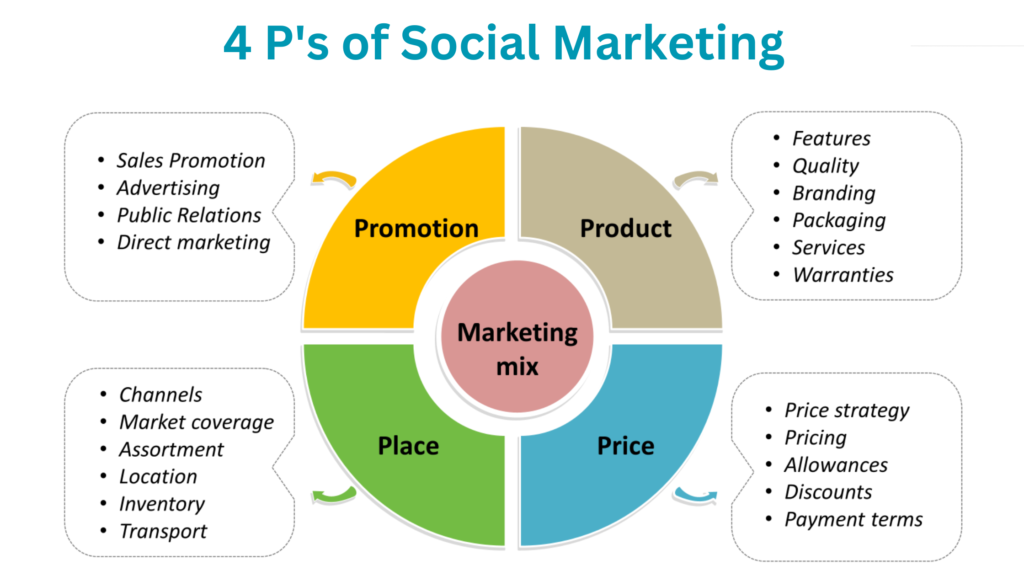Mastering the 4 P's of Social Marketing

Mastering the 4 P’s of Social Marketing
In the ever-evolving landscape of digital marketing, social media has emerged as a powerhouse, offering businesses and brands unparalleled opportunities to connect with their target audiences. As with any marketing strategy, a well-structured approach is crucial for achieving success. Enter the 4 P’s of social marketing, a framework adapted from the classic marketing mix, designed to help you navigate the intricacies of social media marketing effectively.
This comprehensive guide will delve into the nuances of each P, equipping you with the knowledge and strategies to craft a compelling social media presence, engage your audience, and drive tangible results. So, let’s dive in and unlock the true potential of social marketing.
Product: Crafting Compelling Content
In the realm of social marketing, your ‘Product’ encompasses the content you create and share across various platforms. This content serves as the backbone of your social media presence, shaping your brand’s identity and captivating your audience’s attention.
To craft compelling content, it’s essential to understand your target audience’s needs, interests, and pain points. Conduct thorough market research, analyze consumer behavior, and leverage data-driven insights to identify the types of content that resonate most with your audience.
When developing your content strategy, consider incorporating a diverse range of formats, including:
Visual Content: High-quality images, infographics, and videos have a powerful ability to capture attention and convey information in an engaging manner.
Educational Resources: Provide value by sharing industry insights, tips, and tutorials that educate and empower your audience.
User-Generated Content: Encourage your followers to contribute by sharing their experiences, testimonials, or user-generated content (UGC), fostering a sense of community and authenticity.
Interactive Content: Polls, quizzes, and contests not only entertain but also promote audience engagement and gather valuable insights.
Remember, consistency is key. Develop a content calendar and posting schedule to maintain a regular presence and keep your audience engaged.
Price: Perceiving Value
In the context of social marketing, ‘Price’ refers to the perceived value your audience associates with your content and brand. While monetary cost is typically not a factor, the effort required from your audience to engage with your content acts as the ‘Price’ they pay.
To optimize this P, it’s crucial to ensure that the perceived value outweighs the effort required. Offer your audience something meaningful in exchange for their time and attention. This could take the form of:
Free Resources: Provide valuable resources, such as e-books, whitepapers, or templates, to establish your brand as a trusted authority.
Exclusive Insights: Share behind-the-scenes glimpses, industry trends, or expert opinions that give your audience a unique perspective.
Personalized Experiences: Tailor your content and interactions to cater to individual preferences, making your audience feel valued and understood.
Incentives and Discounts: Offer special promotions, discounts, or giveaways to reward your loyal followers and encourage further engagement.
By delivering exceptional value consistently, you create a positive perception that strengthens your brand’s credibility and fosters long-lasting relationships with your audience.
Placement: Reaching Your Target Audience
In the social media landscape, ‘Placement’ refers to the strategic selection of platforms and channels where you will establish your brand’s presence. With numerous social media platforms available, each catering to different demographics and user behaviors, choosing the right ones is crucial for maximizing your reach and engagement.
To determine the optimal platforms for your brand, start by understanding your target audience’s preferences and online behavior. Conduct market research, analyze demographic data, and gather insights from social listening tools. This will help you identify the platforms where your ideal customers are most active and engaged.
Once you’ve identified the appropriate platforms, tailor your content and messaging to align with each platform’s unique characteristics and audience expectations. For example:
Visual-Centric Platforms (e.g., Instagram, TikTok): Focus on creating visually stunning and engaging content, such as eye-catching images, videos, and Instagram Reels.
Professional Networks (e.g., LinkedIn): Share thought leadership content, industry insights, and career-related updates that resonate with professionals and decision-makers.
Microblogging Platforms (e.g., Twitter): Leverage the real-time nature of these platforms to engage in conversations, share news and updates, and interact with your audience directly.
Additionally, consider leveraging influencer marketing strategies to expand your reach and tap into established communities within your industry. Collaborating with influencers who align with your brand values and resonate with your target audience can amplify your message and lend credibility to your brand.
Promotion: Amplifying Your Reach
The final P, ‘Promotion,’ encompasses the strategies you employ to amplify your reach and visibility across social media platforms. In the crowded digital landscape, effective promotion is essential for cutting through the noise and ensuring your content reaches the right audience at the right time.
One powerful promotional tool is social media advertising. Platforms like Facebook, Instagram, Twitter, and LinkedIn offer robust advertising capabilities that allow you to target specific demographics, interests, and behaviors. Leveraging these targeted advertising options can help you reach new audiences, drive traffic to your website or landing pages, and ultimately boost conversions.
Influencer marketing can also play a significant role in your promotional efforts. By collaborating with influencers who have established credibility and a loyal following within your target audience, you can leverage their reach and influence to promote your brand, products, or campaigns.
Community engagement is another crucial aspect of promotion. Foster a two-way dialogue with your audience by actively responding to comments, posing thought-provoking questions, and encouraging user-generated content. This not only strengthens your brand’s connection with your audience but also increases the visibility of your content through shares and mentions.
Additionally, consider implementing cross-promotional strategies across multiple platforms. For example, share snippets of your Instagram content on Twitter or Facebook, or promote your YouTube videos on other social channels. This approach exposes your brand to a wider audience and drives traffic across your various online presences.
Measuring Success: Key Metrics and Analytics
Implementing the 4 P’s of social marketing is essential, but measuring and analyzing the success of your efforts is equally crucial. Social media platforms provide a wealth of data and analytics tools that can help you track your performance and make data-driven decisions.
Some key metrics to monitor include:
Engagement Rate: Track likes, comments, shares, and other forms of engagement to gauge how well your content resonates with your audience.
Follower Growth: Monitor the growth of your follower base across different platforms to understand the effectiveness of your promotional efforts.
Click-Through Rate (CTR): Analyze the number of clicks on your links, ads, or calls-to-action (CTAs) to evaluate the conversion potential of your campaigns.
Reach and Impressions: Assess the visibility of your content by tracking the number of unique users who have seen your posts or ads.
Conversion Rate: Monitor conversions, such as website visits, lead generations, or sales, to understand the direct impact of your social media efforts on your business objectives.
Regularly analyze these metrics and adjust your strategies accordingly. Identify what content and approaches are driving the most engagement and conversions, and double down on those efforts. Additionally, leverage social media listening tools to monitor brand mentions, sentiment analysis, and industry trends, allowing you to stay ahead of the curve and respond proactively to emerging opportunities or challenges.
Best Practices and Tips for Social Marketing Success
While the 4 P’s provide a solid foundation for your social marketing efforts, there are several best practices and tips to keep in mind to maximize your chances of success:
Consistency is Key: Maintain a consistent brand voice, visual identity, and posting schedule across all platforms to reinforce your brand’s credibility and establish a strong presence.
Engage and Respond: Social media is a two-way conversation. Actively engage with your audience by responding to comments, addressing concerns, and fostering a sense of community.
Stay Current: Stay up-to-date with the latest social media trends, algorithm changes, and platform updates to ensure your strategies remain effective and relevant.
Collaborate and Cross-Promote: Leverage strategic partnerships, influencer collaborations, and cross-promotional opportunities to expand your reach and tap into new audiences.
Repurpose and Adapt: Maximize the impact of your content by repurposing it across different platforms and adapting it to suit the unique formats and audience preferences of each channel.
Analyze and Optimize: Continuously monitor your performance metrics, analyze the data, and optimize your strategies based on the insights gained to drive continuous improvement.
Be Authentic and Transparent: Social media thrives on authenticity and transparency. Be genuine in your interactions and communications, and strive to build trust with your audience.
By mastering the 4 P’s of social marketing and implementing these best practices, you’ll be well-equipped to navigate the ever-changing social media landscape, captivate your audience, and achieve remarkable success for your brand or business.


